“I am interested in the concept “Environment”, says Txema Salvans (Barcelona, 52 years old) with the camera in his hands. Environment It is a word that the Baltic-German zoologist Jakob von Uexküll popularized in 1909: it refers to the sensory perception that each animal has of the world. Different creatures can occupy the same space and have different Umwelten: body heat is the core of the Environment ticks, dogs have a sense of smell, elephant fish have electricity. The Umwelt of a stork is not the same as that of Salvans, even though both observe life from above.
For 15 years, Salvans has been taking photos every Sunday morning at the parking of the Carrefour in El Prat de Llobregat when the sun is shining. If you go during the week, you will find families filling their carts with food, but on Sundays, when the supermarket is closed (it is open from Monday to Saturday), the parking lot becomes a liminal space where a non-existent hustle and bustle reverberates. Strange. Is, then, a parking lot without carts, without families, without cars, a parking lot? Can a parking lot become something else? Can a parking lot be a park, a beach, a waiting room?
The supermarket is located near El Prat airport, past one of the largest Amazon logistics centres in Spain and the Baix Llobregat agricultural park, “Barcelona’s vegetable garden”. An extension on the edge of the city where life often goes unnoticed. Salvans’ previous projects, Perfect Day and The Waiting Game (I, II and III), They are also a hotbed of everyday life in post-industrial spaces: prostitutes on the road, families sunbathing next to a factory, dogs waiting in abandoned warehouses. “As we have no way of knowing if another paradise is possible, we are content with these moments of tranquility and even happiness among the cement and the factories,” writes photographer Joan Fontcuberta about Perfect Day. Salvans has been travelling along the Mediterranean coast in his van for years, photographing the Spain that exists beyond the news and extraordinary moments.
“The people in these settings give the matter a tragic dimension,” says Salvans. “What makes us think it’s okay to come and spend a Sunday at the parking “Whether we’re having a sandwich with the family or our son learning to ride a bike? That’s my theme: how we’ve become distant from who we are. It’s what a friend of mine says: ‘We’ve been around longer than we think. ’ That’s where the big friction happens. The gap.”
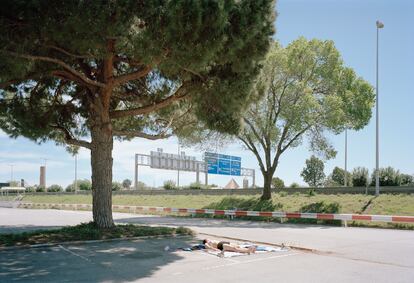
A couple in their 60s take two folding chairs out of the trunk and place them next to their silver-grey Opel Mokka. She has short, dyed blonde hair, well teased, lizard-green eyelids and small touches of glitter, and fuchsia-pink lips. He has brown boat shoes with thick soles, two Sudoku in his hand and the glasses he takes out of his pocket to leave them face down on the cement. “Always face down,” Salvans stresses. The couple fills in the pastime every Sunday until vermouth time.
“I’ve spoken to them,” I say to Salvans. “Do you want to know who they are?”
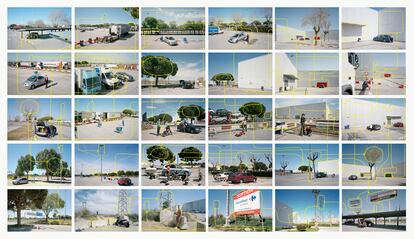
The photographer, who studied biology and now captures life as an ethologist of human unproductivity, avoids talking to his subjects. He doesn’t know their names, what they do, or why they decide to spend, like him, their Sunday mornings in the parking lot of the Carrefour in El Prat. He is solitary and contemplative. He keeps his distance from what interests him in order to protect himself from the discomfort that the world produces in him. One day, some time ago, after returning from one of his photographic trips, his son Jan, then five years old, rushed to hug him and quickly said: “Pare, quina holor a fotos que fas!” (Dad! What a smell of photos you have!). “I use photography as therapy, as a way of protecting my wound and my emotional knot. There is no glamour here,” he says.
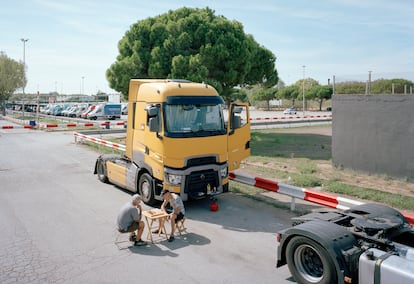
He went on a trip on Wednesday. He played Torrevieja. He came back on Saturday. parking The Carrefour in El Prat de Llobregat awaits him like a home. The morning passes like any other: with his analogue Cambo Wide camera, on a tripod, from the top of his blue van. He carries a rotating amber light and various reflective vests that he uses to transform himself into a surveyor, a technician, a worker, an invisible person. He never moves on foot and the whole choreography tends slightly towards the absurd, as he says: “This is a very boring project, totally absurd.” When he finds the scene he wants to capture, he stops the van at a safe distance, grabs the tripod with one hand and climbs up to the roof of the vehicle, placing his shoe at the intersection between the window and the chassis. He places the camera on the tripod and the horizon moves upwards, making the lines on the ground take centre stage. Salvans moves like a child playing kung-fu while trying not to be seen by adults. He wears his glasses on top of his head. “I always avoid eye contact. “I observe with a peripheral vision.” Salvans unhooks the viewfinder, puts the film in, pretends not to notice, takes the photo. The choreography ends and he smiles. “It is true that there is a deception. But I don’t experience it as a deception.”
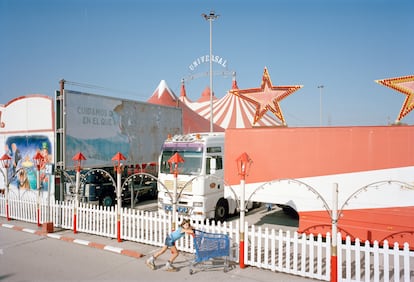
The truck drivers greet him. Some of them are acquaintances. They have been spending 15 Sundays together with him. A pair of Bulgarian brothers are peeling vegetables at the front of the truck. A green plastic basket is attached to the engine and acts as a shelf. With gestures, they invite Salvans to eat. “I have never been invited to eat before,” he says. The truck drivers will spend the day drinking whisky, eating, chatting. An hour later, one of the brothers will give the photographer a pair of maroon sheep wool slippers made by his aunt in Bulgaria. Salvans will say: “Thank you very much, I will take them to Bruna.” His daughter. The truck drivers will spend the night in the parking The next morning they will leave for Paris. Salvans will also go out on a photographic route and take the motorway towards Valencia. He will first pass Carrefour and see the woman and her daughter who today, and for the last eight years, live and sleep in a black minivan. The mother will wear one of those caps with only a visor and will carefully sweep around the car, avoiding the water jugs, while her daughter reads in the passenger seat. “We know them,” says one of the truck drivers. “The father died a few years ago, now it’s just them.” Salvans also knows who they are, but he has never wanted to photograph them.
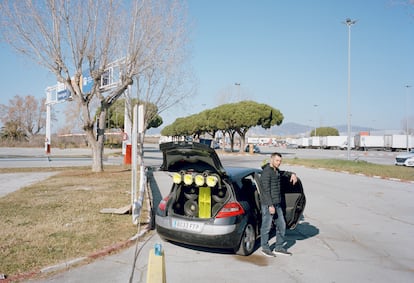
At 12.30, the photographer stops driving around in the van and goes into the Burger King – which is open – to have a coffee. He greets the waiter and asks him if he has already given up his addiction to tobacco and energy drinks. I leave him the tape recorder: “I think the problem is not doing nothing, but what to do when you stop doing nothing. That is the real problem. The big problem of contemporary times is that we are not really doing anything productive, we are not connected, we are always making abstract things. How are we going to fulfil ourselves if there is already someone who does it for us? And now there is not only someone who does it for us, but who thinks for us and makes decisions for us.” Salvans takes advantage of the break to upload some photos to Instagram, which he installed on his mobile because his friend, the acclaimed photographer Martin Parr, told him: “You must have Instagram.” The relationship between the two goes back more than 15 years. Parr once asked Salvans to get him a table at the now closed El Bulli restaurant, a temple of gastronomy. In exchange, Parr would give him a photo of himself, whichever he wanted. Salvans pulled strings, asked some contacts, got that table and chose, as a reward, one of Parr’s most famous photos, one in which two blond children dressed in blue appear, eating an ice cream cone that melts down their arms and stains their faces. Salvans hung the original copy on one of the wooden walls of his children’s room and told them that it was a photo that Parr had taken of them some time ago. Years went by, the children grew up and Bruna
covered the photo of Martin Parr with a silent world map.
#today #Sunday #empty #parking #lot #Carrefour